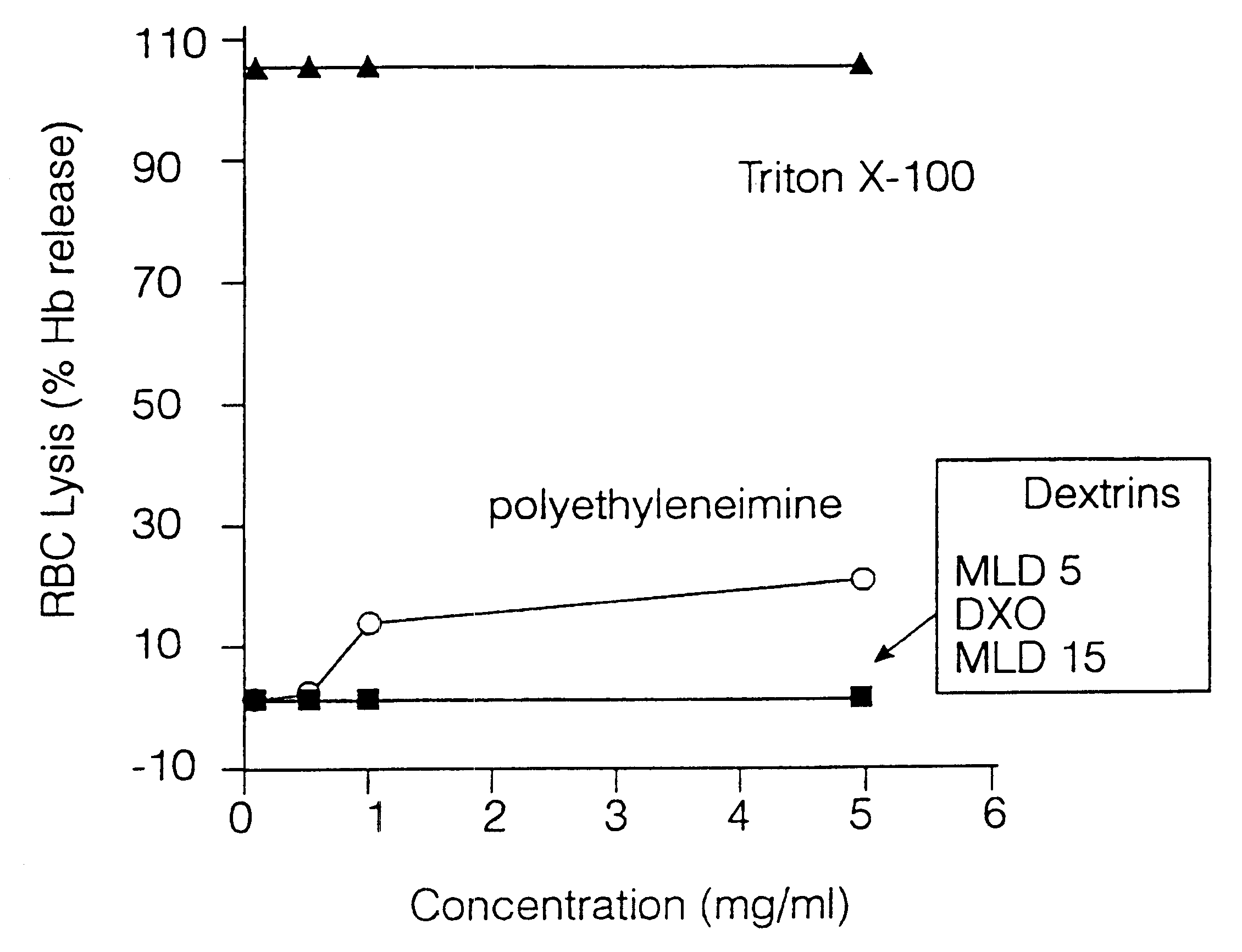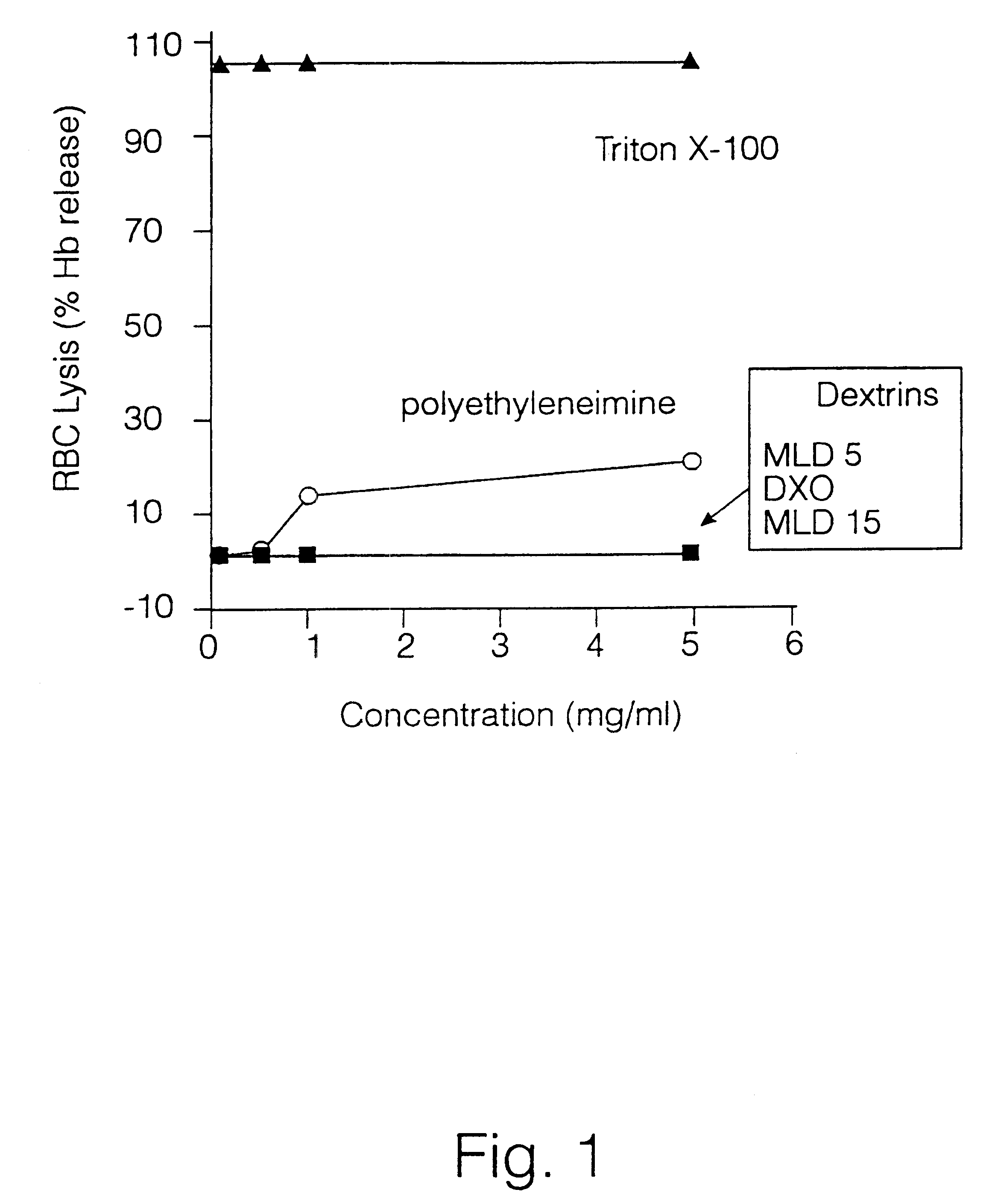Biologically active materials
- Summary
- Abstract
- Description
- Claims
- Application Information
AI Technical Summary
Benefits of technology
Problems solved by technology
Method used
Image
Examples
example 1
Effect of Dextrins on the Stability of Rat Red Blood Cells Incubated in Vitro.
Method
Dextrins of different molecular weight were incubated with isolated rat red blood cells (RBC) and haemoglobin release detected spectrophotometrically. Various dilutions of the test polymers (dextrins) and of the reference polymer polyethyleneimine were made up in PBS and mixed with an equal volume of fresh 2% w / v suspension of rat RBCs. This preparation was centrifuged at 1500.times.g for 10 min at room temperature. Then, 100 .mu.l of the supernatant was removed and the levels of haemoglobin quantitated spectrophotometrically at 5.50 nm. The results illustrated in FIG. 1 were expressed as % lysis relative to that of a Triton X-100 control (Sigma) which gave 100% RBC lysis.
Results
None of the dextrin polymers induced red cell lysis. Polyethyleneimine and the detergent Triton X-100 (control 100% lysis) both caused haemoglobin release.
example 2
Cytotoxicity of Unmodified Dextrins Against L1210 Cells.
Method
L1210 cells were seeded at a density of 1.times.10.sup.4 cells per well into 96 well `v` bottomed microtiter plates (Costar) in RPMI 1640 tissue culture media (Gibeo) supplemented with 10% Foetal Calf Serum (FCS) (Gibeo). All incubations were carried out at 37.degree. C. in an atmosphere of 5% CO.sub.2.
The cells were then left for 24 h. Prior to being incubated with the polymers, the cells were centrifuged at 1000.times.g for 10 minutes at room temperature. This served to pellet the cells and allow the removal of the media. The polymers were then dissolved in RPMI 1640 containing 10% FCS and filter sterilised through 0.2.mu. filters (Aerodisk). Following this, the pellet was resuspended in media containing the appropriate concentration of the dextrins of different molecular weight. Positive and negative reference controls were incorporated, dextran Mw 72 000 (Sigma) as a negative control and poly(L-Lysine) Mw 56 500 (Sigm...
examples
Modification of Dextrins by Succinoylation and Reaction with Compounds Containing Amino Groups ( in relation to (c) above).
All three dextrin samples were modified by means of succinoylation. Initially, attempts to modify the samples to the extent of 50, 20, 10, 5, 2.5 and 1 mol% were carried out. The sample with the highest molecular weight was taken forward for further reaction with tyrosinamide and doxorubicin.
PUM
| Property | Measurement | Unit |
|---|---|---|
| Fraction | aaaaa | aaaaa |
| Time | aaaaa | aaaaa |
| Degree of polymerization | aaaaa | aaaaa |
Abstract
Description
Claims
Application Information
 Login to View More
Login to View More - R&D
- Intellectual Property
- Life Sciences
- Materials
- Tech Scout
- Unparalleled Data Quality
- Higher Quality Content
- 60% Fewer Hallucinations
Browse by: Latest US Patents, China's latest patents, Technical Efficacy Thesaurus, Application Domain, Technology Topic, Popular Technical Reports.
© 2025 PatSnap. All rights reserved.Legal|Privacy policy|Modern Slavery Act Transparency Statement|Sitemap|About US| Contact US: help@patsnap.com



